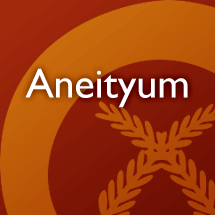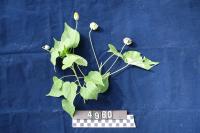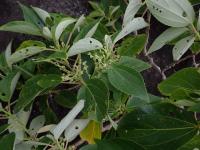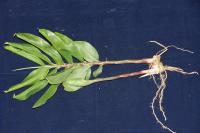Your search for * in clothing has returned 18 entries
elumai
n. cloth (related to nelmai)
bookmarkinhau am̃a
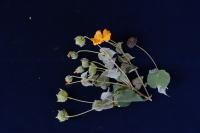
n. shrub, 1. 5 m tall (collection: Gregory M. Plunkett #3560)
Example: In ancient times this plant was used as a fiber to make skirts and rope. Take the stems, remove the leaves, rett the stems in sea water for a few weeks, sun dry the stems and then weave into rope or skirts. This plant is not much used for this purpose at the present time. This plant is used to make a medicine with an unspecified use.
bookmarkinlepei
n. native petticoat
bookmarkna elmai
n. cloth (related to nelmai)
bookmarknajañ
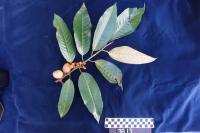
najeng
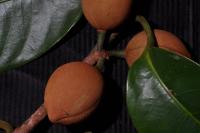
n. tree, 8-10 m tall (collection: Gregory M. Plunkett #4017)
Example: 1. Aerial roots have a natural curve that allows them to be used as a clothing hanger. The outer bark is peeled and dried all day in the sun, before the roots are used. 2. Leaves are used to help remove fish bones lodged in one’s throat. When bones are stuck in one’s throat, then you apply young leaves to the outside of the throat. Apply once and leave until the bones are removed.
bookmarknateg
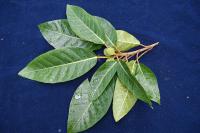
n. tree, 3. 5 m tall (collection: Gregory M. Plunkett #3489)
Example: The fruits of this species are edible. Take the ripe fruits, squeeze coconut milk into the ripe fruits and cook in an earth oven. The leaves are used to wrap small fish caught in a net for cooking in an earth oven. For clothing, strips of bark are peeled and the inner bark removed, and this is used as a strap around the waist, and leaves are tucked in front and back. This is traditional clothing when other clothing is not worn.
bookmarknelm̃ae
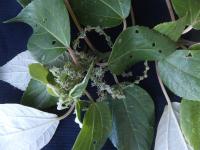
n. small tree. Found in the village, but not cultivated. (collection: Ashley A McGuigan #17)
Example: 1. Ancestors used this plant to make fish line – cut young branches, remove outer bark and tie together, put in salt water or fresh water for a week, it is now strong, dry in sun, take fibers and twist them together to make a very long fishing line. 2. Leaves are used to feed pigs. 3. Take inner bark, scrape it and put on boils. Attach with any leaf and it takes out the boil. 4. Trunk for temporary bush house.
bookmarknelm̃ai
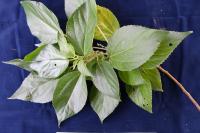
n. tree to 8 m, dbh 10 cm (collection: Michael J. Balick #4863)
Example: Fiber: Collect the stems of this plant, peel off the outer bark, soak (ret) in seawater for 1 week, then put stone on top of it-the fibers are loosened by the retting, peel them off and hang in the sun to dry and bleach. Weave small baskets, grass skirts and other things from this fiber. When sticks are placed in areas of the sea, shells are attracted to these sticks and people can collect the shells used for adornment--the animals in the shells like to eat the material on the sticks. Dried fruits of this plant are eaten by birds.
bookmarknelm̃ai apeñ
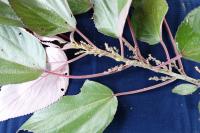
n. tree 6 m tall, dbh 15 cm (collection: Michael J. Balick #4864)
Example: Fiber: Collect the stems of this plant, peel off the outer bark, soak (ret) in seawater for 1 week, then put stone on top of it-the fibers are loosened by the retting, peel them off and hang in the sun to dry and bleach. Weave small baskets, grass skirts and other things from this fiber. When sticks are placed in areas of the sea, shells are attracted to these sticks and people can collect the shells used for adornment--the animals in the shells like to eat the material on the sticks. Dried fruits of this plant are eaten by birds.
bookmarknemek
n. yellow leaves for making petticoats
bookmarknispeheñ
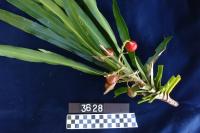
n. sparsely branched tree, 2. 5 m tall (collection: Gregory M. Plunkett #3628)
Example: This plant is used to make a grass skirt for women. There are two different methods decribed. In the first, collect the leaves, tear off 1/2 of the leaf and pleat the halves. Then dry these in the sun by hanging them from the midrib. After they are dry, weave them into a skirt. In the second, take one leaf at a time, tear the leaf down the center and throw away the midrib. The soft part is used in making the skirt by holding a piece of twine between your toes and under your armpit. Weave the length of the twine with the leaf. The let the pieces to dry in the sun for 2-3 days. The skirt can be thrown in the sea before drying to make the skirt white. Bark of inhao is usually used as twine. Retted strips of leaves, later sun dried, can be used to make pillows. When dogs or humans have fish poisoning this plant can help. Take 2 leaves and pound them (use 1 leaf for dogs) and mix with 1/4 cup of water. no further instructions given. (OR - Leaves to cure ciguatera, chew 1 leaf and swallow juice and spit out fiber. Or extract juice into a cup to drink 1x. Give juice + water in cup for dog that is sick.) There is also a belief that you can use the whole stem of this plant as a digging spade to plant sugarcane so the sugarcane is soft and sweet.
bookmarknisvahaijom
n. tree from which petticoats or skirts are made
bookmarknisyeg
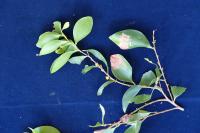
n. tree, 6 m tall (collection: Gregory M. Plunkett #3574)
Example: 1. The inner bark of this plant is used as a dye or paint to provide a brown color. Boil the inner bark in a pot with a shirt and the color of the shirt will be changed to brown. 2. For toothache, people take the inner bark and mix it with sea water, and then rinse the tooth with this mixture to remove the pain. 3a. People macerate the leaves and the bark and when the tide is low, spread this in a pool of water to poison the sea shells that are edible. When they die, the eyes of this organism comes above the sand, indicating where they are, and people harvest and eat them. 3b. To attract and collect clam – NIPJINUMU – scrape bark in a pool of sea water where the clams are attracted immediately and can be collected, coming up from the sand. 4. Firewood, unspecified medical use.
bookmarknisyeg
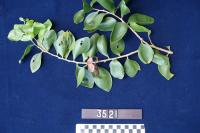
n. tree, 7 m tall (collection: Gregory M. Plunkett #3521)
Example: 1. The inner bark of this plant is used as a dye or paint to provide a brown color. Boil the inner bark in a pot with a shirt and the color of the shirt will be changed to brown. 2. For toothache, people take the inner bark and mix it with sea water, and then rinse the tooth with this mixture to remove the pain. 3a. People macerate the leaves and the bark and when the tide is low, spread this in a pool of water to poison the sea shells that are edible. When they die, the eyes of this organism comes above the sand, indicating where they are, and people harvest and eat them. 3b. To attract and collect clam – NIPJINUMU – scrape bark in a pool of sea water where the clams are attracted immediately and can be collected, coming up from the sand. 4. Firewood, unspecified medical use.
bookmark